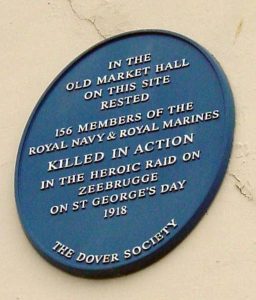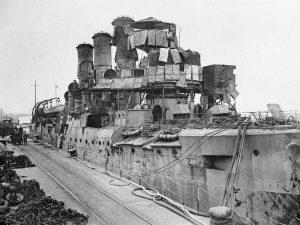
The fifth of the original 10 Dover Society Millennium Plaques was unveiled in October 2000 [the first of two that day]. It is situated on the wall of the Old Market Hall, now the Dover Museum in the Market Square.
This plaque is in commemoration of the casualties of the British raid on the German occupied Belgian port of Zeebrugge on 23rd April 1918, St. George’s Day.
The Royal Navy ships had sailed from Dover and then returned here with the bodies of 156 men of the Royal Navy and Royal Marines. These were placed in a temporary mortuary in what was then the town’s market hall before taken for an honourable burial at St. James’ cemetery, Dover.
Our Vice-President “Budge” Adams, then aged 91, officially installed this plaque and told of his memories when a young boy as he watched the bodies taken into the market hall and later to the cemetery. The buglers present from Dover Sea Cadets (ts Lynx) sounded Last Post and Reveille.
The two pronged raid on Zeebrugge and Calais was to be a blocking raid the aim being – to block the Bruges ship-canal at its entrance into the harbour at Zeebrugge; to block the entrance to Ostend harbour from the sea and to inflict as much damage as possible upon the ports of Zeebrugge and Ostend.
Vice-Admiral Sir Roger Keyes, commander of the Dover Patrol, had planned the operation using about 75 ships and over 1,700 men in a night-time operation. The state of the tide, calm weather, favourable wind for the smoke screen and an absence of fog were all crucial to the plan. Owing to the conditions the raid had been called of twice before.
The intention of the plan was to block the access of German submarines, torpedo boats and ships based at the inland docks in Bruges and were using the Bruges shipping canal to access the English Channel via the two sea entrances at Zeebrugge and Ostend. He would later become Baron Keyes of Zeebrugge and Dover.
At one minute past midnight on 23rd April the diversionary operation to land a force of Royal Marines at the mile-long Zeebrugge Mole began. The storming and demolition forces where to destroy the German gun batteries, seaplane station and defences on it.
The Marines arrived at the Mole on-board an old cruiser ‘Vindictive’ and the Mersey River passenger ferries, ‘Daffodil’ and ‘Iris II’. They were already under heavy fire from the defenders as they arrived “Daffodil” had to push ‘Vindictive’ against the Mole and her Marines had to disembark onto the Mole via the bow of the ‘Vindictive’. They took heavy casualties to the crews manning the guns, and to the Marines and commanders of this storming operation, made worse because of the ineffectiveness of the smoke screen because of a change in the wind direction. “Iris II” could not land her Marines and also took heavy casualties in trying to secure her to the Mole. She then attempted to land Marines via ‘Vindictive’ but only a few men managed to cross before she was withdrawn.
By 12.15 hrs the viaduct bridge connecting the Mole to the shore had been blown up by the submarine ‘HMS C3’. It was driven between the iron pillars of the bridge, the fuses were set and the crew taken on board a launch. ‘HMS C3’ packed with explosives, blew up taking most of the bridge with it. This prevented German reinforcements coming onto the Mole.
After remaining on the Mole for about an hour the storming and demolition forces were evacuated. By 01.15 hrs ‘Vindictive’, ‘Daffodil’ and ‘Iris II’ had collected the survivors and were clear of the Mole on their way back to Dover.

The main objective of the raid was to sink three old British ships, ‘Thetis’, ‘Intrepid’ and ‘Iphigenia’, filled with concrete to block the ship-canal. By 00.45 hrs all three blocking ships were successfully sunk and the crews were rescued by motor launches.
Although the action only lasted a short time the casualties to officers and men were, 176 killed, 412 wounded and 49 missing.
Gallantry Awards
- The following 8 officers and men were awarded the Victoria Cross: Commander (Acting Captain Vindictive) Alfred Francis Blakeney Carpenter, R.N. (Royal Navy)
- Lieutenant Richard Douglas Sandford, R.N. (Commander SC3)
- Lieutenant Percy Thompson Dean, R.N.V.R (Royal Navy Volunteer Reserve) (Motor Launch 282)
- Captain Edward Bamford, DSO, R.M.L.I. (Royal Marines Light Infantry) (commanding numbers 5, 7 and 8 platoons of the marine storming force)
- Serjeant Norman Augustus Finch, R.M.A. (Royal Marines Artillery), R.M.A./12150 (second in command of the pompoms and Lewis guns in the foretop of ‘Vindictive,’)
- Able Seaman Albert Edward McKenzie, N. J31736 (Ch). (O.N is Official Number and Ch is Chatham) (belonged to B Company Seaman Storming Party)
- Lieutenant-Commander George Nicholson Bradford, RN (Royal Navy storming party on Iris II)
- Lieutenant-Commander Arthur Leyland Harrison, RN (took over command of the remnants of B Company Seaman Storming Party on the Mole)
A large number of gallantry awards were made following the raid. A full list of honours, awards, and the names of those who were killed or died of their wounds from the raid is provided by the excellent website at
https://www.naval-history.net/WW1Battle1804ZeebruggeOstend.htm
Alan Lee
